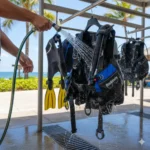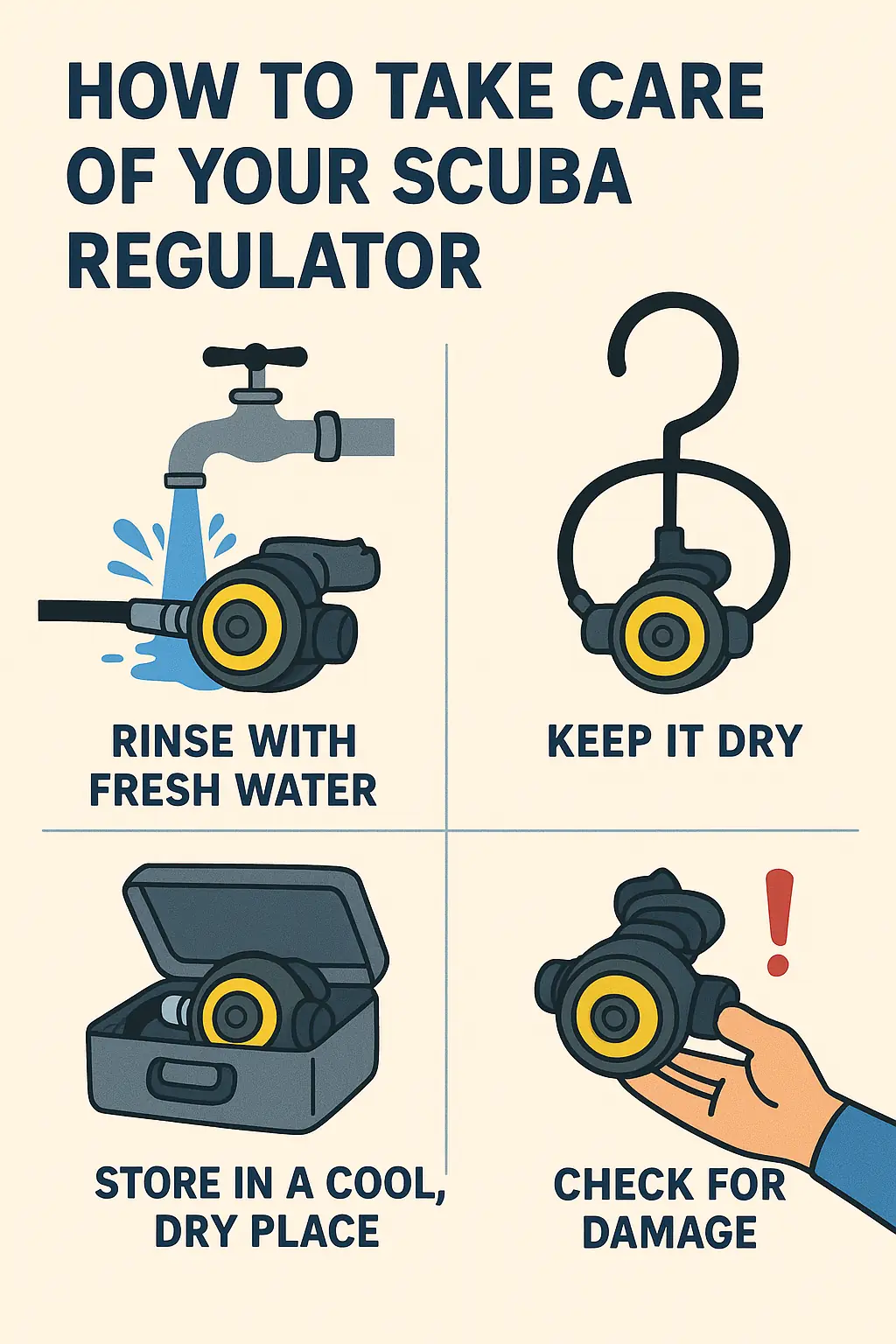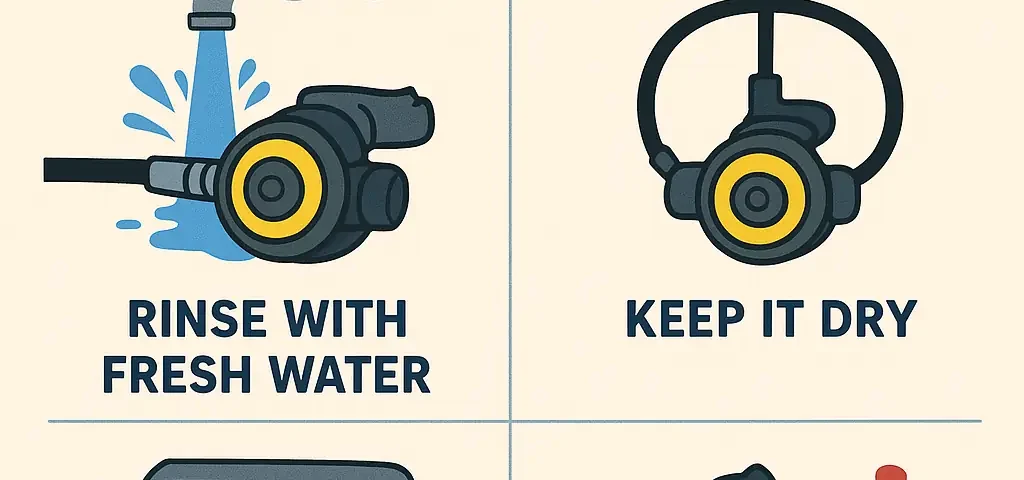
How to Take Care of Your Scuba BCD
October 9, 2025🫧 How to Take Care of Your Scuba Regulator
Your scuba regulator is the life-support link between you and your tank — keep it clean, inspected, and properly stored to ensure safe, reliable breathing underwater. This guide covers step-by-step cleaning after dives, routine checks, storage, annual servicing, and what to avoid.
Quick Overview
Regular care = better performance + longer life. Rinse after every dive, perform monthly inspections, and have a certified technician service your regulator at least once a year (or per manufacturer recommendations).
Immediate After-Dive Care (Every Dive)
- Rinse with fresh water: As soon as you exit the water, rinse the regulator thoroughly with clean, fresh water to remove salt, sand, and chlorine. Use a gentle stream — don’t blast with high pressure.
- Keep the dust cap on: Always secure the first-stage dust cap when the regulator is off the tank to prevent water from entering internal ports.
- Soak if needed: If you dove in very salty or silty conditions, soak the regulator in lukewarm fresh water for 10–30 minutes. This helps dissolve salt crystals and loosens debris.
- Operate second stages gently: While soaking, gently flex hoses and move the second stage out of the water repeatedly to help flush water from internal cavities. Avoid pressing the purge button repeatedly while not connected to a tank.
- Final rinse and dry: Rinse again, then hang the regulator in shade to air-dry. Do not leave it in direct sunlight or inside a hot car.
Daily / Trip Maintenance
- After diving each day, check hoses for kinks, cracks, or soft spots.
- Inspect mouthpieces for tears and replace if worn.
- Ensure all connections (gauge, octopus, inflator hoses) are snug and free from corrosion.
- Record dive usage (number of dives/minutes) if you track service intervals.
Monthly Checks
- Visually inspect all hoses and fittings for age-related deterioration.
- Check O-rings and replace any that look cracked or flattened.
- Confirm dust cap seals properly and is not warped.
- Perform a land-breathing check (connected to a tank): check for free-flow or breathing resistance before every major trip.
Annual / Professional Service
Even with excellent home care, a professional service by a certified technician is essential. Typical service items include:
- Complete disassembly and inspection of first and second stages
- Replacement of wear parts (O-rings, seats, filters) with genuine parts
- Ultrasonic cleaning of internal components
- Reassembly, pressure and leak tests, and breathing performance checks
- Adjustment of intermediate pressure and settings (if applicable)
Service interval guideline: at least once every 12 months or every 100 dives — whichever comes first. If you dive in cold water, silty, or polluted conditions, shorten the interval.
Proper Storage
- Store in a cool, dry place away from direct sunlight and chemicals (fuel, bleach, solvents).
- Keep the dust cap secured on the first stage when not connected to a tank.
- Coil hoses loosely — avoid tight bends or kinks that stress the hose ends.
- Use a padded regulator bag to protect against impacts and dust during transport.
- Ensure the regulator is fully dry before long-term storage to prevent internal corrosion.
What to Avoid
- Do not use household detergents, alcohol, or solvents to clean internal parts.
- Never attempt to open the first stage unless you are a trained technician — high-pressure components are hazardous.
- Avoid exposing hoses and mouthpieces to petroleum-based products or excessive heat.
- Do not attempt to lubricate internal parts with incorrect greases — use only manufacturer-approved lubricants during service.
Travel & Transport Tips
- Disconnect gauges and secure end-caps to prevent damage during luggage handling.
- Wrap second stages and gauges in microfiber or bubble wrap inside a regulator bag.
- If flying, check airline & local regulations regarding tanks and regulators — remove regulators from tanks when not in use or as required.
Simple Home Cleaning Checklist
- Remove regulator from tank and place dust cap.
- Rinse thoroughly with fresh water (gentle stream).
- Soak 10–30 minutes if needed (lukewarm water).
- Gently move second stage to flush water out.
- Rinse again and hang to dry in shade.
- Store in regulator bag when dry.
Troubleshooting — Common Issues & Quick Actions
- Taste of oil/smoke in air: Stop use immediately. Return to a certified technician — this suggests contamination.
- Purge valve stuck or hard to operate: Rinse, dry, and if persists, get serviced.
- Hissing or leak: Check connections and O-rings. If leak from first stage, do not attempt repair yourself — take it to service.
- Free-flowing regulator: Try gently tapping the first stage (on a tank) and check for debris; if it continues, service is required.
Choosing Replacement Parts & Consumables
Always use genuine manufacturer parts (O-rings, seats, filters). Aftermarket parts may be cheaper but can compromise performance and void warranties.
Recommended Items to Keep in Your Regulator Kit
- Spare mouthpiece
- O-ring kit (correct sizes)
- Small silicone lubricant (manufacturer-approved) for external O-rings only
- Microfiber cloths
- Regulator dust cap and padded bag



